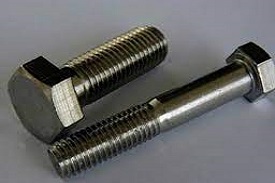
Under product categories A and B, hexagon head bolts, screws, and nuts are essential parts of several mechanical and structural applications. These fasteners are available in a range of sizes, usually denoted as M 1.6 to M 64, to accommodate a variety of industry demands. The six-sided heads of hexagon head bolts and screws are easily gripped with a wrench or socket thanks to their unique shape. When combined with nuts and washers, they offer a sturdy and secure connection. Strict specifications are followed in the production of these fasteners, where grades A and B denote varying degrees of accuracy and functionality. While Grade B gives a little more relaxed tolerance range but still delivers dependable performance in a variety of general-purpose scenarios, Grade A indicates tighter tolerances and better precision, making them suited for applications where accuracy is vital.
Similar in function to these bolts and screws, hexagon head nuts provide a reliable method of fastening. They are made to securely fit the threads of screws and bolts, guaranteeing a strong and secure connection. A wide range of applications, from small electronic devices and machinery to large-scale building and infrastructure projects, are supported by the vast size range, which spans from M 1.6 to M 64. Hexagon head bolts, screws, and nuts are essential components in the fastener industry because they provide strong, trustworthy connections for a variety of applications, including building and bridge construction, consumer electronics assembly, and automotive component assembly.
The specifications for hexagon head screws, especially those that fall within the sizes of M 1.6 and M 64, are outlined in IS 1364 (Part 2):2018. Adherence to IS 1364 (Part 2):2018 aids producers of screws that fulfill particular quality standards, enhancing the dependability and security of goods and constructions that use these fasteners. Producers that follow these guidelines make sure their goods meet legal requirements, which lowers the possibility of legal problems and liabilities. With the help of this standard, screws are guaranteed to be strong and long-lasting for the purposes for which they are designed.
Note: The obligatory ISI Mark Certification must be obtained by manufacturers of hexagon head bolts, screws, and nuts with product classes A and B, more especially hexagon head screws in the size range of M 1.6 to M 64.
These fasteners are widely used in a wide range of sectors, from manufacturing to construction, and their ISI certification is a vital guarantee of their accuracy, quality, and safety. It guarantees the strength, precision, and dependability of these screws over the designated size range by ensuring that the right materials and production techniques are used throughout their creation. This certification attests to the fasteners' compliance with safety regulations, lowering the possibility of structural failure or malfunction in a variety of applications.
Indian Standards Institute, or ISI was renamed the Bureau of Indian Standards (BIS) in 1987. The official mark that the Bureau of Indian Standards provides for manufacturers of various goods is the ISI Mark. It is used to indicate compliance with Indian standards (IS) set by the Bureau of Indian Standards (BIS) and has been used as a conformity marking for industrial products. Manufacturers received permission from BIS to use the ISI Mark on items that comply with relevant Indian requirements through the product certification program.
Only manufacturers (domestic or foreign) who produce the finished product will be awarded ISI Certification. This will not be given to any product importers, traders, dealers, or distributors.
The following documentation is required to get an ISI certification:
For more detailed information, please click here.
There are two approaches for Indian manufacturers to become certified with the ISI Mark:
Regular Procedure
With the possible exception of cases deemed "All India first," which might take up to 180 days, the licensing procedure is expected to be finished in 120 days. This timeline starts on the day the application is received, assuming that at different points in time the documentation, unit assessment, and product conformance are all deemed acceptable.
Step 1: Manufacturing Unit Customization in Compliance with Applicable Indian Standards
Step 2: Submission of the Application Form
For more detailed information, please click here.
Simplified Procedure
This is a much faster process than the standard procedure. After a factory inspection is deemed satisfactory and the initial evaluation establishes that the sample complies with the applicable Indian Standard(s), the license application process is expected to be finished in 30 days.
Step 1: Adapting the Manufacturing Unit to Comply with the Relevant Indian Standard
Step 2: Sample Testing
For more detailed information, please click here
The process of obtaining ISI Mark Certification for Foreign Manufacturers typically includes the following steps:
Step 1: Application
Step 2: Query Raised (If Any)
For more detailed information, please click here.
Brand Liaison provides helpful support for achieving ISI Mark Certification. Among our offerings are:
Please click here to get in contact with our team of specialists for a deeper explanation of the paperwork and steps needed to get ISI Mark Certification.